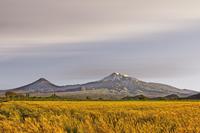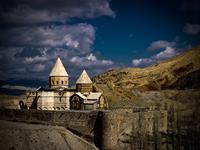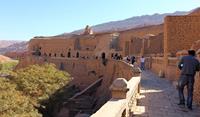Blog home / Behind the Lens with Nuran Zorlu on China's Silk Road

A camera gives a photographer a unique opportunity to view the world in a very specific way. So it's no surprise that award winning photographer, Nuran Zorlu, is also a passionate archivist, sociologist, historian and self-declared foodie.
Nuran is no stranger to mentoring others in his chosen profession. He has taught at a number of prestigious institutions, including the Art Gallery of NSW, the Australian Centre for Photography and TAFE Sydney. In broader circles he is known for his exhibitions and energetic lectures which combine his first loves of philosophy and history with his photography work.
A brilliant example of this combination is Nuran's most recent project, 'Persia to Iran', a travelogue showcasing Iran's most historically and culturally significant sites.
In September 2017, Nuran will lead a unique journey along China's Silk Road, an ideal opportunity for inquisitive travellers to enrich their knowledge of these sites and cultures as well as explore the region through the eyes of a spirited historian and photographer.
We sat down with Nuran in Sydney to find out more about his love for photography and how he uses his passion to connect with the history and culture of the places he travels.
What is it about photography that you love so much?
Photography gives us knowledge and a very commonly used phrase that sums this up is "a picture tells a thousand words". A camera gives the photographer a unique opportunity to view the world in a very specific way. We can focus on the things that matter to us and create some images to explain what we want to say to the viewer.
 KhorpVirap and Mt Ararat. Image: Nuran Zorlu
KhorpVirap and Mt Ararat. Image: Nuran Zorlu
What are your top 3 travel photography do’s and don'ts?
Many of the rules to create a perfect image apply to travel photography, yet with travel photography, we need to capture the feel of the place or the human conditions at its best.
Let's look at the do's first. I am a very disciplined traveller. When I was young, I used to jump onto a train to reach an unknown destination which was great fun. Now, these days I am mainly interested in culture and I would like to fulfill my academic side as well, therefore, knowing the destination is vital for my work. Of course, you can explore a new route or you will find something that grabs your attention when you are on the road. Yet, preparation is very vital. I will say research and organisation is a must do.
One of my favourite Chinese proverbs is 'if I have given 10 hours to cut a tree, I will spend 9 hours to sharpen my axe'.
The second most important thing is dealing with the locals. When I am on location, I always hire a local guide or driver. These people do not only know where they are going, but they are your insurance policy as well. These are the people who know the road closures, safe places, etc.
The third thing is probably the most important one, respect. Every culture has a right to live with their own social codes, as a traveller we might be in their locality for only a day, or even an hour. This notion of respect creates a very positive vibe and eye contact with a smile will open lots of doors.
Ok, now let’s come to the no no's. The first one is not to give money to children for photographs. It’s important to be a child safe traveller and help create a safe tourism environment for children. Instead of giving money directly to children begging or selling food or souvenirs, support their families and communities or donate to reputable children’s charities. {More information about being a child safe traveller here.}
Another thing would be when you are in religious sites, don't take photos non-stop. It is very easy to go from an observer to an intruder.
Your recently published book ‘Persia to Iran’ looks amazing! What were some of the highlights in putting this collection together?
Yes, I published my first book 'Persia to Iran' last year. It was one of the greatest challenges I have ever experienced in my life.
My 'Persia to Iran' book gave me the opportunity to show what I believed in and brought forward an insight into one of the less understood cultures in this world.
As an archivist and social scientist, I have sound knowledge about history, religious components and demography of this region. But when you want to create a collective with all these elements, extensive research is needed. It took me a good ten months to write the book and design the layout. The book was also reviewed by some of the expert's in their field.
 St Thaddeus Monastery Northern Iran. Image: Nuran Zorlu
St Thaddeus Monastery Northern Iran. Image: Nuran Zorlu
You’ve also got a love of food – what’s the strangest thing you have eaten while travelling?
Food is the great part of any travelling experience. I always like to try local delicacies. I am not only a food lover, but I also cook as well.
I don't know where to start...
How about pork feet soup on 4000mt altitude on Armenia's highest mountain Aragats or barbequed intestines in Istanbul, frog leg noodles in Shanghai's busy markets or snails in a local restaurant in Siem Reap, pig ears in a sleepy town near Granada or roasted sheep head as breakfast in Mashad?
What do you think, are they strange enough? Did I mention, my signature dish is Albanian deep fried lamb liver.
 Isfahan Butcher. Image: Nuran Zorlu
Isfahan Butcher. Image: Nuran Zorlu
What can people expect to discover with you on your upcoming trip along the Silk Road in September?
I feel lucky to have had the chance to visit both China's urban and rural corners in the past. This large, culturally rich country has a lot to offer, but to me, a road trip to Eastern China's highly developed regions to the barren ethnically diverse West which is on the ancient Silk Road is one of greatest experiences we can ever have in this country. As this is a new destination for me as well, I am looking forward to photographing and discovering some of the marvels of the world's most populous country too.
 The Forbidden City, Beijing. Image: Nuran Zorlu
The Forbidden City, Beijing. Image: Nuran Zorlu
First of all, The Silk Road is not a single route like California’s Pacific Highway; it is a combination of various land and marital routes which date back to millennia. Before the widespread marine routes established after the 15th century, the land route was the most important for trade and cultural delivery.
Being on the road is an incredible sensation, especially when you are in China. The path we will follow covers more than the half of the Asian Silk Road. From Beijing to Kashgar the distance is around 4500 km (little over the distance between Perth to Sydney.) On this journey, we will experience different cultural elements and diversity of China. There are a few UNESCO heritage sites on our route and we will have a chance to explore some of the least visited corners of the world.
 Exploring the Mogao Caves in China. Image: Kate Baker
Exploring the Mogao Caves in China. Image: Kate Baker
The Silk Road was not only used for a trade, but lots of ideas also passed through this area as well. We will have a chance see the impact of these ideas on this land, especially as a form of religion. Buddhism and Islam entered China through the Silk Road. Today China is officially a non-religious country, but one of the major branches of Buddhism, Han Buddhism, has integrated to China's culture for millennia.
Mogao caves once preserved some of the oldest Buddhist manuscripts. Today it is like an art gallery unlike any other in the world. The manuscripts are not there anymore, but sculptures and murals are still in their original locations. There are also other sites such as Bingling and Labrang monasteries on our route as well. The later is the largest Tibetan Buddhist monastery outside of Tibet. It is a living anthropology museum, the monks and locals still conduct their lives as they did 400 years ago.
The Buddhist infusion in this area is so great, but what I want to explore with my fellow travellers the most are the other religious or ethnic components of Western China, The Uighurs and their amazingly photogenic country.
Of course tasting local delicacies is an imperative aspect of visiting traditional communities which this land offers. I always say you can take amazing images to share what you saw, but the taste and smell sensations will only stay with you.
 Summer Palace. Image: Nuran Zorlu
Summer Palace. Image: Nuran Zorlu
How do you plan to incorporate photography into all the sightseeing and tour activities?
Additional to what we can experience through the land and the culture, I am also looking forward to sharing my expertise as a travel photographer. I will be there to help and guide the participants to develop their technical and artistic styles.
As a social and religious architecture archivist, research is imperative to me. I haven't been to all of these sites but, I know what to look for, and I will find many many more angles the moment I start feeling the place.
Photography is not only a tool to express someone's view of their surroundings, it is also an excellent way to learn new things as well. Personally, I love the epistemology aspect of photography a lot. It helps us to connect and reconnect to our subject, especially if you like to explore culture and history.
My aim for us is to come home with not only a great experience but with a fantastic set of photographs too.
 Tiger Leaping Gorge, China. Image: Nuran Zorlu
Tiger Leaping Gorge, China. Image: Nuran Zorlu
You’ll be heading to the famous Sunday markets in Kashgar. What can people look forward to when exploring the marketplace with you?
The markets are probably the most colourful and exciting part of the trip. The world and The Silk Road has changed a lot, but Kashgar Sunday Markets still exist after millennia. Caravans had stopped here before they advanced into Persia or China. Maybe the items, garments or currency has changed, but the importance of this intersection still plays a vital role. Photographing this market, especially the livestock section, will be one of the highlight of this trip.
This remarkable 15-day journey takes you along the Chinese part of this ancient route, through ever-changing landscape to the ancient city of Kashgar. In the company of multi award-winning photographer, Nuran Zorlu, you will seek out the best photographic experiences and will not fail to be inspired at every turn. Find out more